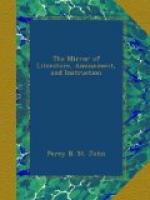A young bee can be readily distinguished from an old one, by the greyish coloured down that covers it, and which it loses by the wear and tear of hard labour; and if the bee be not destroyed before the season is over, this down entirely disappears, and the groundwork of the insect is seen, white or black. On a close examination, very few of these black or aged bees, will be seen at the opening of the spring, as, not having the stamina of those that are younger, they perish from inability to encounter the vicissitudes of winter.—American Farmer’s Manual.
* * * * *
THE ELM.
(To the Editor of the Mirror.)
I shall be obliged to any of your correspondents who can inform me from whence came the term witch-elm, a name given to a species of elm tree, to distinguish it from the common elm. Some people have conjectured that it was a corruption of white elm, and so called from the silvery whiteness of its leaves when the sun shines upon them; but this is hardly probable, as Sir F. Bacon in his “Silva Silvarum, or Natural History, in Ten Centuries,” speaks of it under the name of weech-elm.
H.B.A.
* * * * *
CROP OF BIRDS.
Besides the stomach, most birds have a membranous sac, capable of considerable distension; it is usually called a crop, (by the scientific Ingluvies,) into which the food first descends after being swallowed. This bag is very conspicuous in the granivorous tribes immediately after eating. Its chief use seems to be to soften the food before it is admitted into the gizzard. In young fowls it becomes sometimes preternaturally distended, while the bird pines for want of nourishment. This is produced by something in the crop, such as straw, or other obstructing matter, which prevents the descent of the food into the gizzard. In such a case, a longitudinal incision may be made in the crop, its contents removed, and, the incision being sewed up, the fowl will, in general, do well.
Another curious fact relative to this subject was stated by Mr. Brookes, when lecturing on birds at the Zoological Society, May 1827. He had an eagle, which was at liberty in his garden; happening to lay two dead rats, which had been poisoned, under a pewter basin, to which the eagle could have access, but who nevertheless did not see him place the rats under it, he was surprised to see, some time afterwards, the crop of the bird considerably distended; and finding the rats abstracted from beneath the basin, he concluded that the eagle had devoured them. Fearing the consequences, he lost no time in opening the crop, took out the rats, and sewed up the incision; the eagle did well and is now alive. A proof this of the acuteness of smell in the eagle, and also of the facility and safety with which, even in grown birds, the operation of opening the crop may be performed.—Jennings’s Ornithologia.




